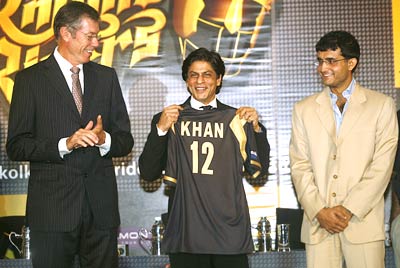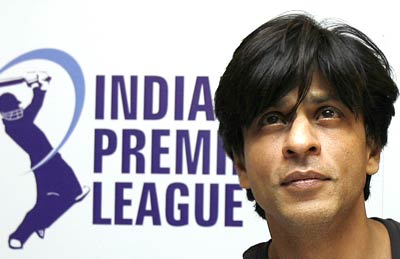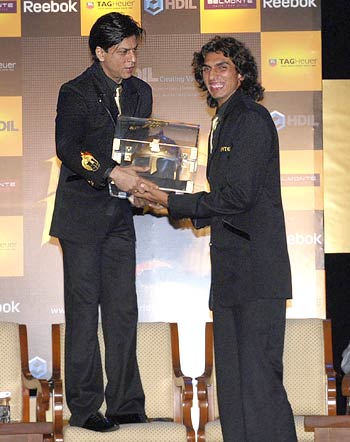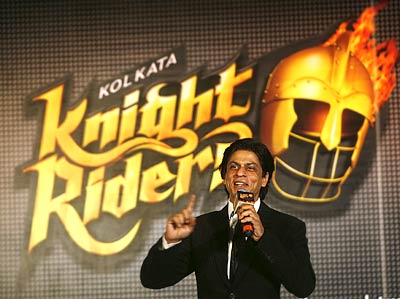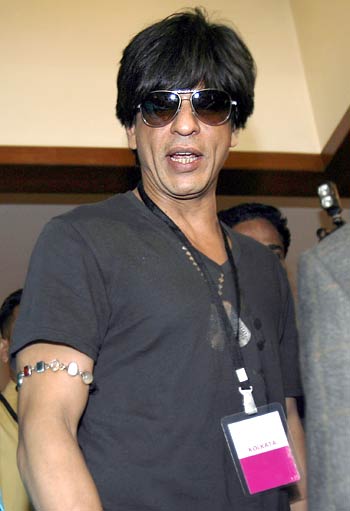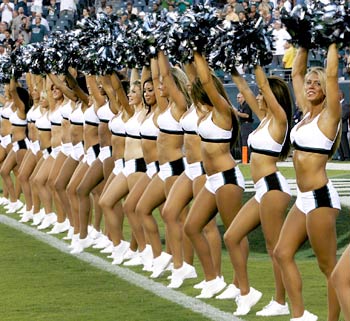 | « Back to article | Print this article |
'Shah Rukh's a fascinating character'
Kolkata: March 10, 2008. It was my first meeting with Knight Riders co-owner Shah Rukh Khan, the first time I felt the magic of the man, a Bollywood king. And the first time I sensed the big picture of what this IPL cricket tournament was all about.
It was a meeting I was anxiously awaiting. If I was going to do the job with his Knight Riders, I needed to be clear that he and fellow-owners Jai Mehta and Juhi Chawla were thinking the same way I was.
I was not sure what to expect from Shah Rukh. On the way over in the plane from Brisbane to Kolkata one of his movies, 'Chak De India' in which he starred as an Indian women's hockey coach, was playing. I watched the film intently to try to get some understanding of the man I was about to meet.
Upon arrival at the ITC Sonar Hotel in Kolkata, the team's home base for IPL matches, I was told to wait in my room until I was called up to meet him. When the moment came I opened his door and walked into his room. He was standing there, phone glued to his ear, cigarette in the other hand, surrounded by a huge entourage including his personal assistant Karuna Badwall, bodyguards and Knight Riders co-owner Jai Mehta. To be honest, it was a bit intimidating.
But Shah Rukh was pretty relaxed and welcomed me warmly. He was eager to show me, prior to the launch of the competition, everything he had done to get the Knight Riders ready for the IPL stage.
He is a fascinating character -- a self-confessed night-owl workaholic who operates from 10 pm until at least 4 am. Then he takes his kids to school, sleeps from mid-morning and resurfaces later in the day. He goes almost around the clock.
He created the Knight Riders because of his love of sport, his affection for cricket and a desire to bring sport to the community.
Excerpted from 'The Future of Cricket, The Rise of Twenty 20', by John Buchanan, Orient Paperbacks, 2009, with the publisher's permission.
You learn lessons in both victory and defeat: SRK
Shah Rukh wanted to combine the history and legends of Kolkata with modern-day entertainment, colour and vision to attract young people to sport. His ideals and values are very close to mine, which is why I thought it would be a very good association.
I think we have a similar width to be innovative and creative in order to share our passion with as many people as possible, while respecting and maintaining traditions. I think it is fair to say we also like to challenge the status quo.
His presence at games was extraordinary. Shah Rukh is a singer and a dancer and to the delight of our fans he would dance mid-match on a stage and try to lift the spirits of supporters and the team.
One of my fondest memories of our association was prior to the first game at Bangalore. I was eager for Shah Rukh to meet with the team ahead of our much-hyped IPL series opener against the Royal Challengers.
There was some delay with his arrival -- which is not unusual in India -- due to his unbelievable popularity. When he finally arrived, I had tremendous pleasure in introducing each member of the team to him. One could see he was visibly moved and happy to be there.
He was a star, but he was also humble. He never imposed himself on the team. As owner, he never just marched into the dressing room. He always asked could he come into the dressing room. He would say to me: 'You are the coach, but I want to be around to support you.'
And when he did come in, he lavished gifts on the team -- computers, sound systems, phones. He was trying to say 'we want to win', but it was also all about effort and trying to prevail. He would say: 'You learn lessons in both victory and defeat.'
SRK was loyal, humble and had never forgotten where he came from: Buchanan
Each man of the match in clashes between the Knight Riders and opponents at Kolkata would be presented with a medieval-style gold helmet funded by Shah Rukh. It was an extraordinary trophy.
Once he took me, along with our team director Joy Bhattacharya and a couple of our support staff to watch him on the set of his latest film, 'Billu Barber'. We spent the whole day watching what we later found out was the filming of just one quarter of a song! This particular movie set, in the hills outside Mumbai, was designed to replicate the streets and scenes of the historic city of Ahmedabad. The set took 40 days to erect and covered a massive area, and then it was torn down again once filming was complete.
We were guests in Shah Rukh's on-site movie trailer, a relic he had been using for 15 to 20 years. It reflected his humble upbringing and fleshed out the man behind the movie star. We also met the people he had been surrounded by in the movie industry for the last 10 or 15 years. Meeting those people highlighted to me that 'SRK' was loyal, humble and had never forgotten where he came from. Observing him at work was amazing. Shah Rukh is amazing. His work ethic is amazing. His attention to detail is extraordinary.
Married to Gauri, Shah Rukh is a walking icon. Wherever he goes he is worshipped. And not just by Indians. He recently visited Germany and was mobbed. People continually hug him.
In Australia when you greet people, you shake hands. But Indian greetings are different. They greet by hugs. You hug everybody. I found that interesting to begin with. Australians are accustomed to a certain degree of personal space, but in India there is no such thing. There is very little space to go around, so people immediately invade your personal space. That is how I felt -- like my space was being invaded -- although Indians do not see it that way.
In India it is up close and personal all the time. So each time we met each other, Shah Rukh and I would hug.
'Our owner was the glue who everyone gravitated towards'
He cherished our successful moments and was in raptures during and after McCullum's amazing 158 in the opening game. Even before the excitement of that innings, before the game, Shah Rukh was out dancing on the ledges of Chinnaswamy Stadium. Fireworks preceded the start of the match; it was a light and sound show to kick off the tournament.
And then there was Shah Rukh -- he was the entertainment beyond the entertainment. And that was him throughout the tournament. His emotions were transparent, infecting and inspiring everyone around him.
'Our owner was the glue who everyone gravitated towards,' praised my assistant coach Matthew Mott. 'He was feted by everyone, he was larger than life, but he was a personality who got involved. He treated everyone the same and was a big influence on the group.' McCullum observed: 'He is such a modest man. You'll never feel overawed by his presence.'
Ajit Agarkar said: 'He is fantastic. All the owners were. We had a string of losses in the middle and they were still upbeat despite putting a hell of a lot of money into the team. He is a megastar, a massive star, but for him to be so humble around the team, it gives you a nice feeling when he and the other owners have been so supportive.'
Shah Rukh's enthusiasm was not always convenient. After our first home game against Deccan we were ushered back to our hotel and into a conference room at 11.30 pm. Shah Rukh brought in a sponsor, who made a speech and a presentation of gifts to the entire squad. This took place after every game.
If Hewlett-Packard was the designated sponsor, everybody got a computer. We didn't always win, but Shah Rukh wanted to show his support regardless. We felt embarrassed about receiving gifts that we didn't feel our performances warranted.
I had a couple of conversations with Shah Rukh about it. At the same time, the team understood that as professional sportspeople we had obligations and so we were obliged to take part, but SRK said he'd try to be cognizant of our concerns in future.
'Shah Rukh refused to enter our dressing room'
It was one of the most controversial moments of the IPL. If there was a more recognisable face at the IPL than Shah Rukh, I didn't meet him. But he got caught up in a security crackdown sparked by bombings in the city of Jaipur, a terrorist attack which took place about two-thirds of the way through the IPL.
This particular security manager, Niranjan Singh Virk, who was head of the anti-corruption and security unit of the ICC, prevented Shah Rukh entering the Knight Riders dressing room at Eden Gardens. Shah Rukh was curious about what Virk wanted. He thought there was a serious problem when he was pulled aside, but as the interview proceeded Shah Rukh realised he was merely being questioned because he was not carrying the correct accreditation.
Shah Rukh became feisty, as he can be, and as a protest our co-owner refused to enter our dressing room for the remaining games until it was made clear by IPL officials why he had been singled out by the security manager.
IPL Chairman Lalit Modi publicly supported Shah Rukh, saying he should never have been challenged. But Shah Rukh remained furious and stayed away from our rooms. His presence was still felt though, as his text messages increased in frequency and detail.
'Story time boys I told you if you keep losing you have to bear with my long, boring msgs. This is your punishment,' was one typical introduction to a message of inspiration. The message went on to compare our unsuccessful season with a movie that flops ('all of us have become part of a failed script'). He urged the players to 'keep our characters worthy of still looking back at this story and remembering it as a special story'.
'Many times I have made movies which don't do well But I have a way of dealing with flop stories. I enjoy the work So chin up and don't spoil your characters.'
This message was leaked to the press, which annoyed Shah Rukh no end. But what the text message did show the outside world was his support and respect for the team even though we were struggling to win matches. When the chips were down, he showed his true colours. That trait is the mark of a noble man.
'I suspect the cheerleaders are here to stay'
On the field there were player spats, like Harbhajan Singh slapping Sreesanth and the Shane Warne-Sourav Ganguly clash.
Away from the middle there was the internal-drama-turned-public-fracas between the Royal Challengers Bangalore management, owner Vijay Mallya and the players. Meanwhile the Knight Riders' own Shoaib Akhtar was a walking media magnet.
And then there were the cheerleaders. Scantily clad they came and an uproar they created. Oh, what a drama. The Washington Redskins cheer squad was drafted in to perform on the opening night of the IPL. They were the trial-blazers in a foreign landscape, the forward party in an off-field entertainment extravaganza, which was to accompany all 59 IPL matches. And so they did, but by tournament's all 59 IPL matches. And so they did, but by tournament's end all cheerleaders would be wearing more clothing than the Redskins girls did on opening night.
Cheerleaders came from around the world. Bangalore had the well-publicised Washington squad, white Hyderabad recruited women from Australia and Canada. As foreigners, we were used to seeing pretty young girls with not many clothes on dancing in front of your face. You see them at rugby league matches, basketball games and the like.
But in India, women dancing around in tight-fitting outfits caused affront to some people. Judging by some of the banners declaring love and proposing marriage, many fans enjoyed it -- especially the young men -- but it was too much, too quickly for many.
Some followers were silent in their protest. Others were more upfront with their feelings. Leading politicians and even some players protested their presence. The Mumbai police ousted cheerleaders prior to a match at DY Patil stadium after public complaints about their attire. It was widely reported that cheerleaders across the IPL were subjected to propositions and obscenities.
There was an alleged racism row before the Chennai Super King clash with Kings Punjab, with two English cheer girls claiming they had been told not to perform because they were 'black'. This allegation was strenuously denied.
There was no suggestion of gender bias at Chennai or Mumbai. Mumbai employed six males and six females to dance on the sidelines during games, while Chennai introduced a local flavour, gathering an all-Indian squad comprising five boys and seven girls. The Chennai Super Kings franchise promoted their cheer squad as the 'brothers and sisters' of fans attending home matches.
Through the trails and tribulations, the cheerleaders stayed and performed at most games. By the end of the tournament they were far more conservatively dressed than at the beginning, but there is no doubt they added to the colour, atmosphere and spectacle. I suspect they're here to stay.
Excerpted from 'The Future of Cricket, The Rise of Twenty 20', by John Buchanan, Orient Paperbacks, 2009, with the publisher's permission.
